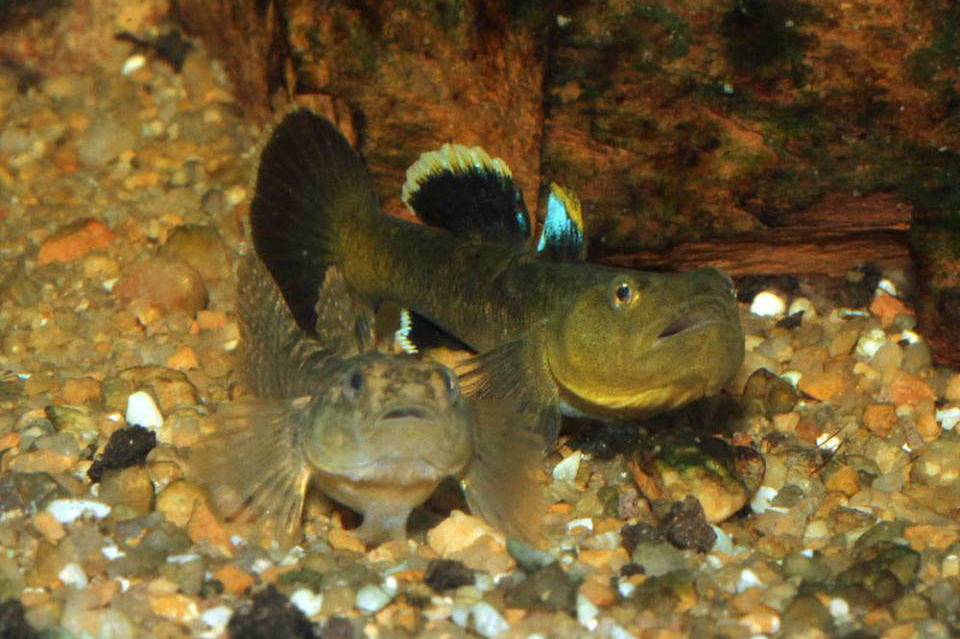Finke Goby, Chlamydogobius japalpa Larson 1995

Male and female Finke Gobies, Chlamydogobius japalpa. Source: Dave Wilson / Aquagreen. License: All rights reserved
The Finke Goby is very similar in appearance to the Desert goby, Chlamydogobius eremius - differing in having a pattern of wavy lines, 7-8 predorsal scales and a partially-scaled breast (vs marbled blotches on head, predorsal scales absent or inconspicuous and scattered, and scales absent from breast in C. eremius).
Finke Goby, Chlamydogobius japalpa Larson 1995
More Info
|
Distribution |
Known only from upper Finke River system, Northern Territory: from Ormiston Gorge to the junction of Maloney Creek and the Finke River. Inhabits relatively permanent pools, usually with rock, sand or fine gravel substrate, often sheltering among vegetation or detritus on sand. |
|
Features |
Dorsal fin V-VI + I, 7-8; Anal fin I, 5-8; Caudal fin (segmented rays) 16 (branched rays) 15-16; Pectoral fin 12-14; Pelvic fin I, 5; TRB 14-19; GR 2-3 +5-6 = 7-9; Vertebrae 10-11 + 18-19 = 28-29. Body rounded to slightly compressed anteriorly, compressed posteriorly. Head short, somewhat rounded, length 3.2-3.7 in SL. Snout rounded to somewhat inflated and partly overhanging upperlip. Anterior nostril in very short tube, on edge of preorbital, tube oriented down and forward, preorbital curved forward slightly to accommodate nostril. Posterior nostril oval, halfway between front edge of eye and edge of preorbital. Eyes lateral, high on head, top usually part of dorsal profile, 3.0-5.1 in HL. Interorbital broad, flat; top of head, from rear of interorbital space up to snout tip, with scattering of very fine pigmented villi. Lips usually smooth, lower lip free at sides, fused across front. Mouth terminal to subterminal, slightly oblique; upper jaw slightly overhanging lower jaw, generally reaching to below mid-eye in males and to below front half of eye in females; teeth of upper jaw in 3-4 rows, outermost usually larger than others, stout and curved or almost upright, others slightly smaller; teeth of lower jaw in 4-5 rows; teeth of males slightly larger than females; tongue large, round to bluntly rounded. Gill opening restricted to pectoral base; inner edge of shoulder girdle smooth. |
|
Size |
To around 5.5 cm SL |
|
Colour |
Pale yellowish brown, anterior half of body generally darker than posterior half, with 6 brown to greyish brown square saddles across back and one across nape and opercles, saddles mostly composed of blotches and dark vermiculations partly connected to each other laterally by irregular lines and small blotches; saddle across nape mostly broken up into darker brown vermiculations; anterior part of head with vermiculate greyish brown marbling and small spots, relatively unmarked, most distinct pattern being dark brown vermiculations on snout and anteriorly on interorbital; dark brown bar from front of eye to upper lip; dark irregular line dorsally on snout to tip. Fins pale brownish to fawn; axil of pectoral base pale with dark brown vermiculations. |
|
Feeding |
Omnivore - feeds on insect larvae, crustaceans, filamentous algae, fish eggs and detritus. |
|
Biology |
Oviparous, benthic spawner. Females lay adhesive demersal eggs in crevices from November to March. Males guard the eggs, fanning them almost constantly until the larvae hatch. |
|
Conservation |
IUCN Red List: Vulnerable |
|
Etymology |
The specific name is from the Indigenous Australian Western Aranda name Japalpa, given to part of the Finke River near the Ormiston Creek type locality - a significant site in Aranda traditions. |
|
Species Citation |
Chlamydogobius japalpa Larson, 1995, The Beagle: 32, figs 3-4, 7-8. Type locality: Ormiston Creek, at junction of Pioneer Creek, 23°40'S, 132°42'E, Finke River, Northern Territory. |
|
Author |
Bray, D.J. 2025 |
|
Resources |
Finke Goby, Chlamydogobius japalpa Larson 1995
References
Allen, G.R., Midgley, S.H. & Allen, M. 2002. Field Guide to the Freshwater Fishes of Australia. Perth : Western Australian Museum 394 pp.
Hammer, M. 2019. Chlamydogobius japalpa. The IUCN Red List of Threatened Species 2019: e.T122914080A123382416. https://dx.doi.org/10.2305/IUCN.UK.2019-3.RLTS.T122914080A123382416.en. Downloaded on 01 October 2020.
Larson, H.K. 1995. A review of the Australian endemic gobiid fish genus Chlamydogobius with descriptions of five new species. The Beagle, Records of the Museums and Art Galleries of the Northern Territory 12: 19-51 figs 1-14 pls 1-2 See ref at BHL
Larson, H.K. 2001. A revision of the gobiid fish genus Mugilogobius (Teleostei: Gobioidei), and its systematic placement. Records of the Western Australian Museum, Supplement 62: 1-233
Larson, H.K. & Martin, K.C. 1990. Freshwater Fishes of the Northern Territory. Northern Territory Museum of Arts and Sciences Handbook Series Number 1. Darwin : Northern Territory Museum of Arts and Sciences 102 pp. 73 figs. (p. 62, as Chlamydogobius eremius in part, as only one species was recognised in the genus at the time)
Larson, H.K. & Murdy, E.O. 2001. Eleotridae, Gobiidae. pp. 3574-3604 in Carpenter, K.E. & Niem, T.H. (eds). The Living Marine Resources of the Western Central Pacific. FAO Species Identification Guide for Fisheries Purposes. Rome : FAO Vol. 6 pp. 3381-4218.
Mossop, K.D., Lemmon, A.R., Lemmon, E.M., Eytan,R., et al. 2023. Phylogenomics and biogeography of arid-adapted Chlamydogobius goby fishes. Molecular Phylogenetics and Evolution 182: 107757, https://doi.org/10.1016/j.ympev.2023.107757
Unmack, P.J. 2001. Biogeography of Australian freshwater fishes. Journal of Biogeography 28: 1053-1089
Wager, R. & Unmack, P.J. 2000. Fishes of the Lake Eyre Catchment of Central Australia. Brisbane : Department of Primary Industries and Queensland Fisheries Service 88 pp.










